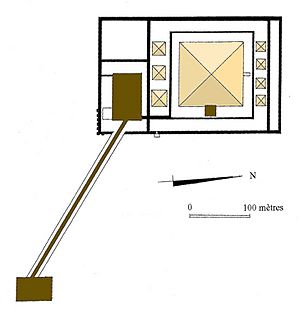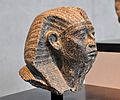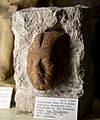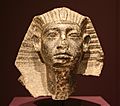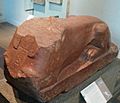Senusret III facts for kids
Quick facts for kids Senusret III |
|
|---|---|
| Sesostris III, Senwosret III | |
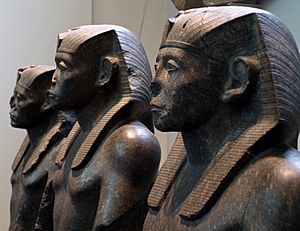
Statues of Senusret III in the British Museum
|
|
| Pharaoh | |
| Reign | 1878 – 1839 BC (Twelfth Dynasty) |
| Predecessor | Senusret II |
| Successor | Amenemhat III |
| Consort | Neferthenut, Khnemetneferhedjet II, Itakayt, perhaps Meretseger |
| Children | Amenemhat III, Khnemet, Menet, Mereret, Senetsenbetes, Sithathor (?) |
| Father | Senusret II |
| Mother | Khnemetneferhedjet I |
| Died | 1839 BC |
| Burial | 29°49′9″N 31°13′32″E / 29.81917°N 31.22556°E |
| Monuments | Buhen and Toshka |
Senusret III (also known as Sesostris III) was a powerful pharaoh of Ancient Egypt. He ruled from 1878 BC to 1839 BC. This was a time of great strength and wealth for Egypt. He was the fifth king of the Twelfth Dynasty during the Middle Kingdom. Many people think he was the strongest Egyptian ruler of his dynasty.
Senusret III's military actions brought a time of peace and economic growth. He also reduced the power of local rulers called nomarchs. This led to a boost in art, trade, and city growth. Senusret III was one of the few Egyptian kings who were honored like a god while they were still alive.
Contents
Family Life
Senusret III was the son of Senusret II and Khenemetneferhedjet I. We know for sure about three of his wives: Itakayt, Khenemetneferhedjet II, and Neferthenut. Their tombs were found near his pyramid at Dahshur.
He had several daughters, including Sithathor, Menet, Senetsenebtysy, and Meret. Their exact relationship to the king is not fully clear. His son, Amenemhat III, most likely became the next king.
Great Achievements
Senusret III made a special canal through the first waterfall (cataract) of the Nile River. This helped boats travel more easily. He also worked hard to expand Egypt's control into Nubia, a region to the south. Between 1866 and 1863 BC, he built huge forts along the river. These forts included Buhen, Semna, Shalfak, and Toshka.
He led at least four major military trips into Nubia. These happened in his 8th, 10th, 16th, and 19th years as king. A stone tablet (stela) from his 8th year at Semna tells about his victories against the Nubians. These wins helped make Egypt's southern border safe.
Another important stone tablet from Semna, from his 16th year, talks about his military actions in both Nubia and Canaan. On this tablet, he told future kings to keep the new border he had created:
Year 16, third month of winter: the king made his southern boundary at Heh. I have made my boundary further south than my fathers. I have added to what was bequeathed me. (...) As for any son (i.e., successor) of mine who shall maintain this border which my Majesty has made, he is my son born to my Majesty. The true son is he who champions his father, who guards the border of his begetter. But he [who] abandons it, who fails to fight for it, he is not my son, he was not born to me. Now my majesty has had an image made of my majesty, at this border which my majesty has made, in order that you maintain it, in order that you fight for it.
The Sebek-khu Stele is another important stone tablet from Senusret III's time. It records the earliest known Egyptian military trip into the Levant (an area in the Middle East). The text says: "His Majesty proceeded northward to overthrow the Asiatics. His Majesty reached a foreign country of which the name was Sekmem (...) Then Sekmem fell, together with the wretched Retenu". Sekmem is believed to be Shechem, and Retenu is linked to ancient Syria.
His last military trip, in his 19th year, was not as successful. The Nile River was lower than usual, and his forces had to pull back. They did this to avoid getting stuck in enemy Nubian land.
Senusret III was so strong and important that later generations worshipped him as a god in Semna. He also built a temple and a town in Abydos, and another temple in Medamud.
How Long He Ruled
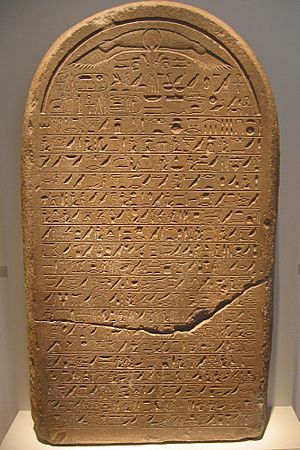
A special paper (papyrus) found in the Berlin Museum shows "Year 20" of Senusret III's rule next to "Year 1" of his son, Amenemhat III. This might mean that Senusret III and his son ruled together for a time. Some experts believe Senusret III ruled for 39 years, with his son ruling alongside him for the last 20 years. Other experts disagree and think his son Amenemhat III simply continued to work on his father's buildings.
Pyramid and Burial Place
Senusret III's pyramid complex was built northeast of the Red Pyramid in Dashur. It was much bigger and grander than earlier pyramids from the Twelfth Dynasty.
Some people think Senusret III might not have been buried in this pyramid. They believe he might have been buried in his special tomb complex in Abydos. His pyramid might have been a cenotaph, which is a monument built for someone buried elsewhere.
Senusret's pyramid was 105 meters (about 344 feet) square and 78 meters (about 256 feet) high. It was built with a core of mud bricks. The burial chamber inside was lined with strong granite. Above the burial chamber, there were other chambers with huge limestone beams, each weighing 30 tons.
The pyramid complex also had a small temple for ceremonies and seven smaller pyramids for his queens. There was also an underground area with more burials for royal women. Here, treasures belonging to Sithathor and Queen Mereret were found.
Royal Statues

Senusret III is famous for his unique statues. They are easy to recognize because of his serious expression. On some statues, he looks older, with deep-set eyes, lines on his cheeks, and a stern mouth. His ears are also very large. But, even with these realistic facial features, the rest of his body is shown as young and strong, like other pharaohs.
Experts have different ideas about why Senusret III chose to be shown this way. Some think he wanted to appear as a serious ruler, full of worries and responsibilities. Others believe the statues were meant to show him as a powerful leader who saw and heard everything. More recently, it's been suggested that these statues showed the idea of royal power at that time, rather than just being a realistic picture of him.
Gallery
-
British Museum Senwosret's name on belt from the three statues (far right).
See also
 In Spanish: Sesostris III para niños
In Spanish: Sesostris III para niños



